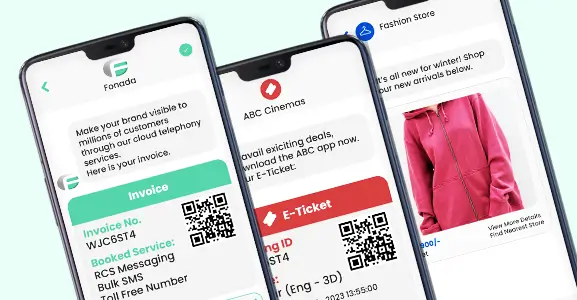UCaaS, a transformative acronym for Unified Communications as a Service. It represents the fusion of Internet-based telephony and messaging within a ubiquitous communications field. UCaaS empowers businesses by offering collaborative tools that eliminate geographical boundaries for organizations and help them operate seamlessly across various channels. These days, UCaaS has become an integral tool for businesses aiming to streamline their communications and want to align all the systems they use for business communication.
In this blog post, we will discuss everything you need to know about UCaaS technology and how it helps businesses streamline their flow of communication within the business environment.
What Is Unified Communications As A Service (UCaaS)?
Unified Communications as a Service (UCaaS) can be divided into parts: “unified communications” and “as-a-service”. Unified communication refers to platforms designed to work with multiple communication technologies simultaneously and help businesses streamline their communication flow from a single portal. The “as-a-service” refers to software as a service (SaaS), which enables organizations to leverage all the features of UCaaS on a flexible pay-as-you-go basis.
With Unified Communications (UC), businesses enable seamless interactions across multiple channels and utilize various modes of communication like phone calls, chats, and video conferencing. Hence we can say UCaaS technology is the remedy to the chaos spawned by numerous disconnected communication applications. It combines VoIP, video conferencing, instant messaging, and collaboration tools into one unit and amplifies productivity.
How Does UCaaS Work?
UCaaS revolutionizes communication within the business environment and helps them to have high-end contact center capabilities. With these capabilities, they can optimize operations and cater to customers’ needs and queries without investing in expensive VoIP hardware. When you avail of UCaaS service from reliable service providers, they take care of everything from security to backend configuration, ensuring a smooth and hassle-free experience for businesses.
Let’s understand the working functionality of UCaaS with the help of a few pointers
- UCaaS software systems are cloud-based tools hosted and managed by third-party service providers like 8×8, Fonada, etc
- This software does not require installation, backend configuration, or maintenance of internal hardware like VoIP servers or phone lines.
- UCaaS providers use IP telephony technology for voice and video calling.
- VoIP works by condensing audio inputs into data packets transmitted over broadband.
- VoIP phone numbers are driven by SIP trunking technology (Universal Session Initiation Protocol).
- With the help of SIP, real-time communication sessions are initiated, run, and terminated
- UCaaS removes technical complexity, with infrastructure functionality handled by the service provider.
- To run a UCaaS software, you only need a reliable internet connection.
VoIP is the sole element of UCaaS that emperors the core functionalities of voice communication. It breaks all the received sounds into data bricks and transmits them to a cloud telephony service provider. All the voicemails and phone numbers function using the Universal Session Initiation Protocol (SIP).
With UCaaS, businesses can efficiently achieve scalability, enhance productivity, and embraces the future of work. Creating a customized UC platform requires expensive setups and frameworks, but with UCaaS data centers, businesses can simplify the complexities of all the processes and offer innovative solutions for seamless communication within the business environment.
What Are The Key Components Of UCaaS?
The five major key components of UCaaS are voice, video, messaging, collaboration, and cloud. These key components empower businesses to strategize their organizational workflow.
Let’s understand the uniqueness of each component and how it helps businesses
Voice: UCaaS systems work with advanced contact center technology, empowering them to offer high-end voice capabilities that transcend traditional boundaries. These capabilities enable businesses to leverage call forwarding, call recording, and advanced call routing through a unified system.
Video: With web-based conferencing bring people together regardless of distance and engage them in one-on-one or multi-participant meetings infused with a personal touch.
Messaging: Instant real-time messaging embraces the freedom of individual and group-based conversations that breathe life into your discussions.
Collaboration: With collaboration tools, schedule your operations, messaging, and project management.
Cloud-based: UCaaS platforms are cloud-based, which mean all your essential services are hosted securely over the Internet by your service provider’s data center.
What Is The Difference Between UCaaS And CPaaS?
UCaaS and CPaaS may rhyme in pronunciation, but they are completely different in their methodologies and working functionalities.
The key differentiating factors between UCaaS and CPaaS are given below:
UCaaS
- UCaaS (Unified Communications as a Service) offers advanced cloud communication solutions that do not require extensive technical expertise or hardware installation
- It aims to bring all communication features together in an all-in-one platform, accessible without coding or complex technical knowledge.
- UCaaS is best for non-developers seeking a ready-to-use communication solution.
- UCaaS softwares are enriched with advanced features that include voice, video, messaging, and collaboration tools in one package, requiring no coding or technical skills.
- UCaaS allows users to utilize its features and benefits without barriers or complexities
CPaaS
- CPaaS (Communication Platform as a Service) is specially designed for developers seeking to integrate voice and text capabilities into their applications.
- CPaaS enables developers to incorporate specific voice and messaging functionalities into their software using APIs
What Are The Benefits Of Unified Communications
A streamlined flow of communication is essential for operational efficiency and improved productivity. Cloud Unified Communications tools do the same just by combining all the elements involved in communication within the business environment.
Here are possible reasons to help you understand why your obsolete PBX is not meeting your expectations and it is time to upgrade to UCaaS.
Enhanced Productivity: Unified Communications merge various communication channels into a single platform and help businesses have enhanced productivity and result-oriented decision-making.
Improved Connectivity: The immigration capabilities of UCaaS make it unique from other tools and systems. It seamlessly integrates voice, video, messaging, and other communication channels, enabling users to stay connected regardless of location or device.
Cost Savings: UCaaS is a cloud-based platform that does not require any external hardware or software configurations for functioning. It empowers organizations to scale their communication infrastructure as per their needs
Simplified Management: With a centralized platform, it becomes easier for businesses to manage operations, helping them focus on other factors for better productivity.
Flexibility and Mobility: Remote working allows employees to access communication tools and collaborate seamlessly from anywhere, enabling flexible work arrangements and increasing productivity.
Enhanced customer experience: Contact center capabilities of UCaaS empower organizations to deliver enhanced customer service to their customers.
Integration with existing systems: Seamlessly integrate UCaaS solutions with your existing business applications and systems for enhanced productivity.
Scalability: With UCaaS, businesses can easily scale their communication infrastructure up or down as per their needs.
What Are The Pros And Cons Of UCaaS?
However, UCaaS systems are designed to assist you with all your communication needs within a business environment. Nonetheless, it is important to bear in mind that they also have certain disadvantages when transitioning from traditional PBX to Cloud Unified Communications.
UCaaS Advantages
- Cost savings
- Flexibility
- Team collaboration
- Enhanced Productivity
- Improved agent’s performance
- Streamlined technology stack for better efficiency
- Scalability and reliability
UCaaS Disadvantages
- Need of high-speed internet connectivity
- Limited scope for emergency calling
Things To Be Considered While Selecting UCaaS Service Provider?
If you search for a UCaaS service provider on the web, you will come across numerous suggestions. However, choosing the best one can be daunting, especially if you are new to this.
That’s why it is important to remember the following tips when selecting a UCaaS service provider:
Reliability and Uptime: Before selecting a service provider, check provider’s track record for online service delivery and minimum downtime.
Scalability: Ensure whether the provider is capable enough to accommodate your business need and offer scalable solutions or not
Feature Set: Make sure the service provider offers all the features that are must to align with your specific communication requirements.
Integration Capabilities: Determine whether the UCaaS solution seamlessly integrates with your existing systems and applications.
Security and Compliance: Ensure the service provider follows all the security measures and compliance certifications to protect your sensitive data.
Quality of Service: By evaluating, you can determine whether the provider’s network infrastructure guarantees high-quality audio and video communication.
Customer Support: Make sure that the customer support options of the service provider are responsive enough to take strict and immediate measures to deal with unwanted issues
Cost and Pricing Model: Before paying for the service, make sure that the pricing structure of the service provider meets your budget.
Reputation and Customer Reviews: Read customer reviews, and find references to gauge their overall customer satisfaction
Conclusion
UCaaS has emerged as a complete solution for organizations looking to revolutionize their way of communication in the business environment. It is equipped with an advanced comprehensive suite of unified communications tools and services that help them ensure a seamless flow of business communication.
The future of cloud unified communications is bright as new technologies, such as artificial intelligence and machine learning, continue to enhance their capabilities, empowering UCaaS to become smarter and faster.
FAQs
UCaaS solutions are cloud based communication platforms enriched with integration capabilities that enable businesses to access collaboration tools, such as voice, video, messaging, and conferencing from a single platform.
UCaaS, or Unified Communications as a Service, helps businesses streamline their flow of communication within the business environment. With UCaaS, businesses can leverage collaboration tools to enhance productivity and streamline their communication
Dependency on high-speed internet connectivity, security concerns, and potential service outages are a few potential disadvantages of UCaaS
UCaaS monitoring is all about actively analyzing the performance, availability, and quality of UCaaS solutions to ensure user satisfaction and optimal functioning
Discover UCaaS (Unified Communications as a Service) services and how it empowers businesses here. Learn more now.
UCaaS encompasses various communication and collaboration tools into a single platform, whereas the hosted VoIP refers specifically to the cloud-based delivery of voice communication services.

Dec 11, 2024
Top Contact Center Optimization Tools For 2024
“A thriving business knows how to fetch maximum output from limited resources by optimizing ca... Read More
Nov 13, 2024
What Is Brand Communication? CPaaS Role Explained
Did you ever wonder why some advertisements grab your attention instantly, while others do not? The... Read More
Nov 01, 2024
What Is Automated Messaging And How Does It Work?
Automated messaging or text automation empowers businesses and marketing professionals to connect wi... Read MoreLatest Updates
From Fonada
Industry Insights, Trends, Innovations, Updates, and Case Studies from Industry Experts
View
Customer
Reviews
Discover why our customers love us - read their authentic and heartfelt reviews!
View
Case
Studies
Explore real-life scenarios, offering analysis, and solutions to practical challenges
View
Convert Leads Into Sales With Fonada
Trusted CPaaS Solution Provider








